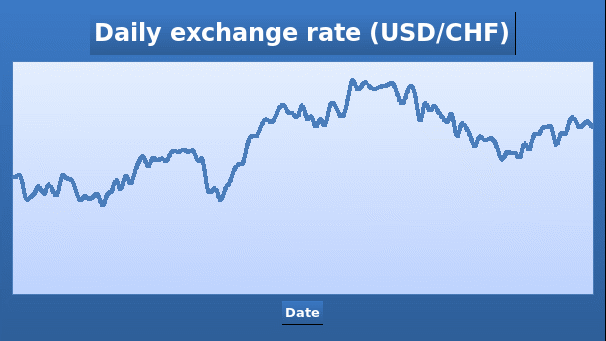Switzerland is one of the most developed economies in the world. The country ranks nearly at the top in most of the economic metrics. For instance, it tops in terms of nominal wealth per adult and eighth in terms of per capita GDP. It also tops in other areas such as quality of life, human development, and government transparency among others. The country is one of the most stable and wealthy economies in the world. In 2012, the exchange rate between the two currencies was 0.9399. From 2012, there has been minimal movement between the two currencies. Further, from 2016 to date, there has been a slight depreciation in the value of CHF. This is due to several economic factors.
The United States has one of the strongest economies in the world. The US is a superpower and an increase in the value of the currency lowers the value of other currencies. The country suffered an economic recession between 2007 and 2008 (Viney & Phillips, 2015). However, it has recovered and the economy is booming again. The paper will focus on analyzing the exchange rate between the two countries. The analysis will cover the period between 1st September 2016 and 28th February 2017.
Analysis
Data
(Source of data – Fusion Media Limited, 2017).
Table 1. Exchange rate. The table contains data for the USD/CHF exchange rate for the period between 1st September 2016 and 28th February 2017.
Chart

Discussion
In chart 1 above, the exchange rate fluctuated during the period of analysis. From an economic point of view, Switzerland is one of the most prosperous and stable nations across the globe. Besides, the country continues to display strength and stability even during a period of low-interest rate and crisis. The currency (Swiss Franc) is a haven among traders. This is because the country is always impartial on political matters and economical issues that concern the Euro Zone. Globally, CHF accounted for 2.2% of all Forex Spot transactions (Kallianiotis, 2013). When compared to other currency pairs, USD/CHF is one of the least liquid pairs. It offers a smooth market trend as shown in the graph above. Therefore, CHF displays low inflation and unemployment level and sturdy economy, unlike the USD that get effects immensely by issues such as high debt level and budget deficits (Frenkel & Johnson, 2013).
Similarly, USD has shown stability over the years and is used as a reserve currency. Further, some countries have pegged their currencies on the USD because of its steadiness. Thus, the currency is also safe heaven. Despite the stability of both USD and CHF, several factors affect the currency pair. A major factor that caused the movement shown in the graph above is political turmoil. The US had elections during the last quarter of the 2016 financial year. This contributed significantly to the changes observed above. Besides, the political climate in Switzerland also contributes to the volatility of the pair.
Another factor that affects the pair is the extent of disparity in interest rate between the Swiss National Bank and the Federal Reserve. For instance, if the Federal Reserve decides to move in a certain direction to help the dollar strengthen, then this may cause the value of the USD/CHF to go up as observed between 1st November 2016 and 1st January 2017. Thus, the upsurge that is observed in the graph can partly be explained by the appreciation of the US Dollar when compared to the CHF. Interest differential plays a significant role in the movements that are observed above (Miller, 2014).
Another factor that contributes to the fluctuations that are observed in the graph above is the strong negative correlation between the currency pair and EUR/USD. Thus, the tilting of USD/CHF is not in favor of EUR/USD. This explains why volatility is felt most during the European open. During this period, Switzerland has few economic releases and the currency pair to move towards the USD (Economic Calendar News Analysis and Forecasts, 2017). Some factors that independently affect the USD and CHF may also affect the pair. Examples of these factors are GDP index, consumer price index, trade balance, unemployment level, and consumer confidence among others.
Conclusion
The discussion on currency pair shows that the United States and Switzerland are two strong economies. They are world leaders in different areas. Besides, the two countries are prosperous and wealthy. Both the USD and CHF have been stable over a long period. They are considered a haven. The currency pair is also stable and less liquid as compared to other pairs. Despite the stability, the chart shows that there has been some movement experienced in the currency pair. Some of the factors that contributed to these movements are political turmoil and interest rate differential among others. The future of this pair is quite bleak following the refusal of the Swiss National Bank to disclose some financial information. The US is likely to impose a sanction which is likely to affect the stability of this pair.
References
Economic Calendar News Analysis and Forecasts. (2017). USD/CHF news and analysis. Web.
Frenkel, J. A., & Johnson, H. G. (2013). The economics of exchange rates (collected works of Harry Johnson): Selected studies (8th ed.). New York, NY: Routledge.
Fusion Media Limited. (2017). USD/CHF – US dollar swiss franc. Web.
Kallianiotis, J. N. (2013). Exchange rates and international financial economics: History theories, and practices. New York, NY: Palgrave Macmillan.
Miller, N. C. (2014). Exchange rate economics: the uncovered interest parity puzzle and other anomalies. Cheltenham, UK: Edward Elgar Publishing Limited.
Viney, C., & Phillips, P. (2015). Financial institutions, instruments and markets (8th ed.). Maidenhead, Queensland: McGraw-Hill Education (Australia) Pty Ltd.